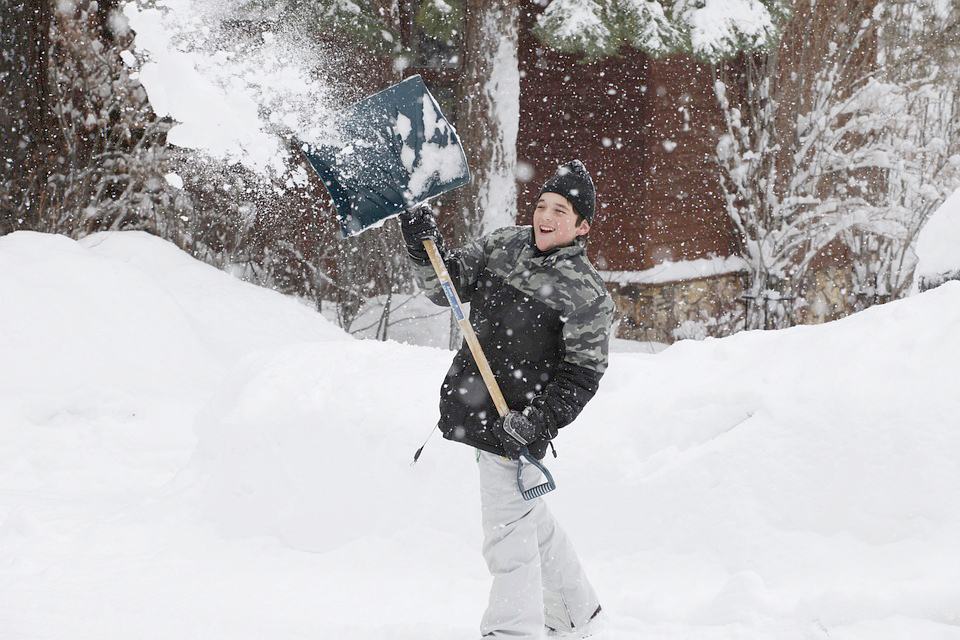This article originally appeared in the January 2020 edition of Senior Scope. Article by Cam Bergeron, CSCS, Cam’s Conditioning & Rehab. Photo courtesy Unsplash.
As fall ends, our days become shorter, the temperature decreases and, occasionally, we are gifted with snow. Being prepared for snow – and snow removal – will save you from injuries during the winter months.
Step one is to pre-treat your walkways with salt or sand. Go outside and salt your walkways hours before or the night before the snow arrives. If you have to shovel, then these are some ways to stay safe.
The type of snow that is falling will determine the way you remove it. When it comes to removing light, fluffy snow, my suggestion is to go outside with a broom multiple times during the storm. You can use a broom to easily remove lighter, dryer snow from walkways. Since the snow is light, you will have no problem using a side-to-side motion with the broom. Stand in the middle of your walkway with your chest up, shoulders back, flat back and abs tight.
While maintaining this posture, move the broom from left to right and keep walking. This method will make it so you do not have to bend or lift any snow. This method may or may not work for your driveway, depending on the size of it. If the broom technique isn’t working for you, then you can pick up the shovel.
When it comes to shoveling, the same rules apply as the broom. Go out multiple times during the storm. If you are going outside after every couple inches of snowfall, you shouldn’t have to lift the shovel. Instead, you can keep the shovel on the ground and “plow” your driveway.
Stand with proper posture (as stated above) with the shovel in front of you. Keeping proper posture, walk forward, pushing the shovel. If you have a long driveway or walkway and the snow is filling up the shovel too much, try pushing snow from left to right. The less weight on the shovel, the better.

What not to do: If you must pick up your shovel to remove snow, toss the snow forward and to the side. Do not twist your torso to fling snow.
If you do need to pick up your shovel, know that you are creating a lever system that directly affects your lower back – and it can hurt your back when done incorrectly.
Think of your arm as a lever. The weight is in your hands, which is the distal part of the lever. Every time you lean forward to pick up snow, you are putting a decent amount of weight at the very distal end of that lever.
When your body is not in proper posture (in other words, if you’re rounding your back), each shovel full will directly affect your lower back. Take smaller scoops when shoveling. This will help decrease pressure on the shoulders and lower back.
The other technique I personally use is the pivot technique. This helps keep the knees, hips and lower back safe while manipulating a heavy shovel.
Typically people will rotate their torsos to throw snow to the side. The better way is to throw the snow forward and slightly to the side. This makes it so you don’t have to rotate your torso, which decreases pressure on the lower back.
If you must move the snow off to the side, then the pivot technique will help a lot. If you are shoveling, stand with staggered stance (left foot forward, right leg back), shovel some snow, pivot your right heel out and your body will go to the left. Then drop the snow and return.
The rotational force during this movement comes from the hip, not the lower back. Power derives from the hips, and pivoting the feet will help save your lower back from injury as well as making each shovel full easier to move.
After you finish shoveling, always remember to throw down sand or salt. This will help melt the ice and make your yard a lot safer to walk around.
You will need to identify which one of these methods works best for your needs. The technique will depend on the style of your driveway, the type of snow and the amount of ice in the forecast.


Recent Comments